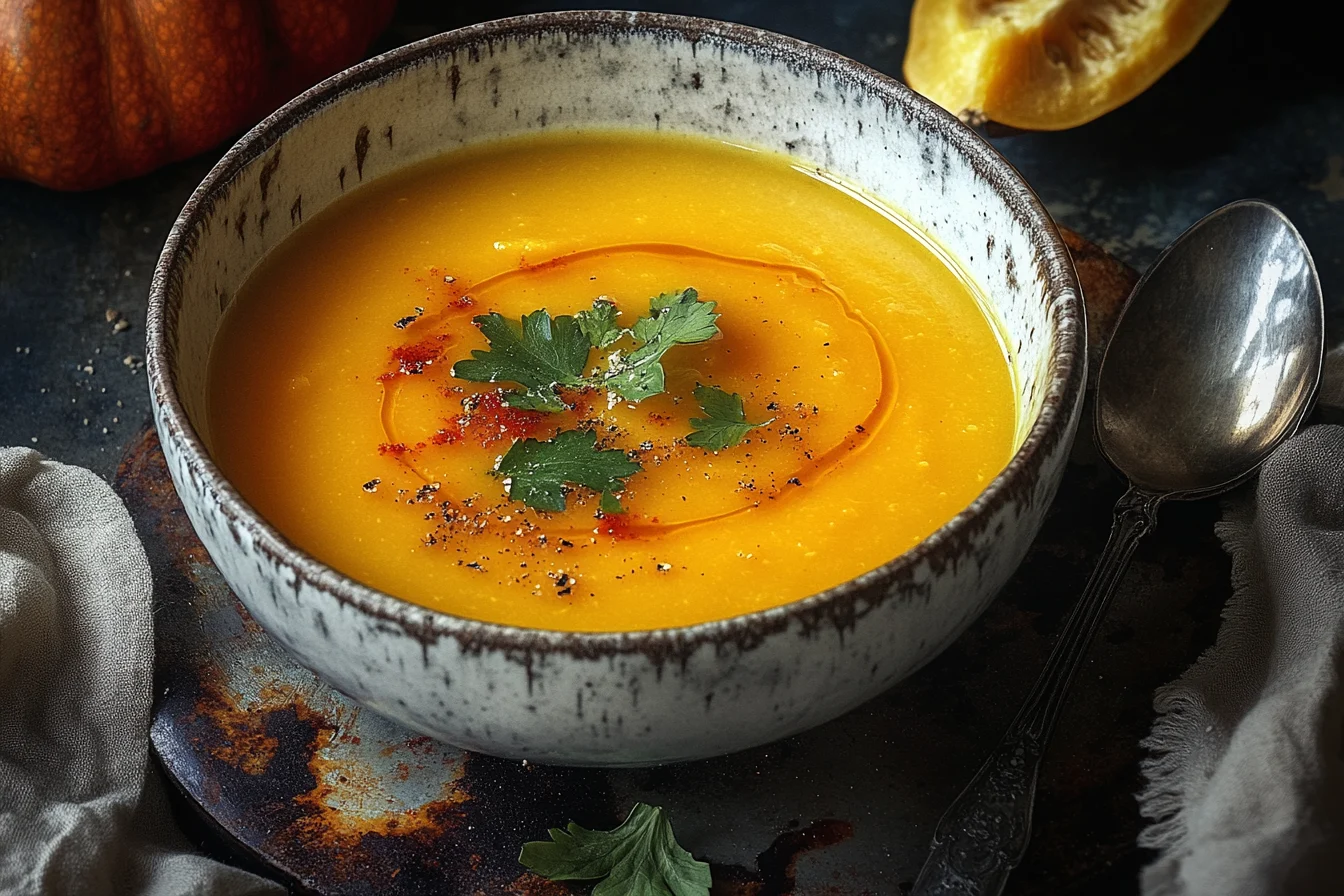Kabocha squash soup is a creamy, rich, and hearty dish made from the kabocha squash, a Japanese pumpkin known for its sweet, nutty flavor and velvety texture. This soup is a favorite in global cuisines, prized for its versatility and the way it blends beautifully with both sweet and savory elements.

Whether you enjoy it as a light starter or a satisfying main course, kabocha squash soup delivers comfort with every spoonful. From cozy family dinners to elegant dinner parties, it’s a dish that’s easy to adapt to your needs.
Origins and Popularity in Global Cuisine
The kabocha squash, native to Japan, is celebrated in Asian, American, and European cuisines alike. Its thick, flavorful flesh lends itself perfectly to soups, curries, and roasted dishes. In Japan, kabocha squash soup is often served as a seasonal treat during fall and winter.
In the West, kabocha squash soup has gained popularity as a healthier, flavorful alternative to butternut squash soup, appreciated for its natural sweetness and creamy consistency without needing heavy cream.
The Unique Flavor of Kabocha Squash
Kabocha squash stands out for its sweet, nutty flavor, often described as a cross between pumpkin and sweet potato. Its velvety texture makes it ideal for purées and soups. When roasted, its caramelized sugars create a deep, complex flavor.
Sweet, Nutty, and Velvety Texture
- Sweetness: The natural sugars balance well with spices like cinnamon or savory elements like garlic.
- Nutty Undertones: These add depth, making it a sophisticated base for soups and stews.
- Creamy Texture: Blending cooked kabocha creates a smooth, luxurious soup without the need for additional cream.
Health Benefits of Kabocha Squash Soup
Kabocha squash soup is not only delicious but also packed with essential nutrients and health benefits. Its nutrient-dense profile makes it a guilt-free indulgence.
High in Vitamins, Low in Calories
- Rich in Vitamins A and C: Supports immune health and glowing skin.
- Low in Calories: With only about 40 calories per cup, it’s a perfect choice for weight-conscious individuals.
- Minerals like Potassium and Magnesium: Help regulate blood pressure and muscle function.
Anti-Inflammatory Properties
Kabocha squash is loaded with antioxidants such as beta-carotene, which helps reduce inflammation and combat oxidative stress. It’s also high in dietary fiber, promoting healthy digestion and sustained energy levels.
Choosing the Perfect Kabocha Squash
Selecting the right kabocha squash is essential for a flavorful soup.
How to Select a Ripe Kabocha Squash
- Weight: A ripe kabocha should feel heavy for its size.
- Skin Color: Look for a dark green, slightly dull surface with some light orange streaks.
- Stem: A firm, dry stem indicates freshness.
Seasonal Availability
Kabocha squash is most commonly available in fall and winter, aligning perfectly with seasonal cravings for warm, comforting dishes. While fresh kabocha is ideal, pre-cut squash can be a convenient option.
Fresh vs. Pre-Cut Squash
- Fresh Squash: Offers maximum flavor and texture, but requires extra effort to cut and peel.
- Pre-Cut Squash: Saves time but may lose some sweetness and nutrients if not used immediately.
Tools Needed for Kabocha Squash Soup
Having the right tools makes preparing kabocha squash soup much easier.
Must-Have Kitchen Equipment
- Sharp Chef’s Knife: Essential for cutting through the tough skin.
- Large Spoon: To scoop out seeds and flesh.
- Blender or Immersion Blender: For achieving a silky, smooth texture.
- Heavy-Bottomed Pot: Ensures even cooking and prevents scorching.
Alternatives for Special Diets
Kabocha squash soup can easily be adapted for various dietary needs:
- Vegan: Use coconut milk or almond milk instead of cream.
- Gluten-Free: Naturally gluten-free, but double-check garnishes like croutons.
- Dairy-Free: Opt for olive oil or plant-based butter for sautéing.
Variations of Kabocha Squash Soup
Kabocha squash soup lends itself to countless adaptations based on regional and personal preferences.
Regional and Cultural Adaptations
- Japanese Style: Features dashi broth, soy sauce, and a drizzle of sesame oil for umami richness.
- Thai-Inspired: Combines kabocha with coconut milk, ginger, and red curry paste for a spicy twist.
- Western Variations: Incorporates cream, nutmeg, and roasted garlic for a hearty, classic flavor.
Preparing Kabocha Squash Soup: Ingredients, Techniques, and Recipe
Ingredients for Kabocha Squash Soup
To create a flavorful and creamy kabocha squash soup, gather these key ingredients:
Essential Ingredients for the Base
- 1 medium kabocha squash (about 2–3 pounds).
- 2 tablespoons olive oil or butter.
- 1 medium onion, chopped.
- 2 garlic cloves, minced.
- 4 cups vegetable or chicken stock.
- 1 cup coconut milk, heavy cream, or dairy-free alternative.
- Salt and pepper to taste.
Flavor Enhancers and Garnishes
- Spices: Cinnamon, nutmeg, or ginger for warmth.
- Herbs: Fresh thyme, parsley, or cilantro for a bright finish.
- Toppings: Toasted pumpkin seeds, croutons, or a drizzle of cream.
Prepping the Kabocha Squash
Kabocha squash has a tough exterior, but with the right tools and techniques, it’s easy to prepare.
How to Cut and Peel Kabocha Squash
- Stabilize the Squash: Place the squash on a sturdy cutting board.
- Cut in Half: Use a sharp chef’s knife to slice the squash in half from top to bottom.
- Scoop Out Seeds: Use a spoon to remove seeds and stringy pulp.
- Peel the Skin: For a smoother soup, remove the skin with a vegetable peeler or sharp knife. (The skin is edible and can be left on for a rustic texture.)
Roasting Techniques for Extra Flavor
Roasting the squash caramelizes its natural sugars, adding depth to the soup.
Steps for Roasting Squash
- Preheat the oven to 400°F (200°C).
- Brush the squash halves with olive oil and sprinkle with salt.
- Place the squash cut-side down on a baking sheet lined with parchment paper.
- Roast for 40–50 minutes or until tender.
- Let cool slightly, then scoop out the flesh.
Pro Tip: Add a sprinkle of cinnamon or nutmeg before roasting for a subtly spiced base.
Step-by-Step Recipe for Kabocha Squash Soup
This classic recipe results in a creamy, flavorful soup perfect for any occasion.
Classic Creamy Kabocha Squash Soup
Ingredients:
- Prepared roasted kabocha squash (about 4 cups of flesh).
- 2 tablespoons olive oil or butter.
- 1 medium onion, diced.
- 2 garlic cloves, minced.
- 4 cups vegetable or chicken stock.
- 1 cup coconut milk or heavy cream.
- Salt and pepper to taste.
Directions:
- Sauté Aromatics: Heat olive oil or butter in a large pot over medium heat. Add onion and garlic, sautéing until soft and fragrant.
- Add Squash and Stock: Add the roasted kabocha squash flesh and stock to the pot. Bring to a simmer.
- Blend Until Smooth: Use an immersion blender to purée the soup directly in the pot. Alternatively, transfer to a blender in batches and blend until smooth.
- Stir in Coconut Milk: Return the soup to low heat and stir in coconut milk or cream. Adjust salt and pepper to taste.
- Serve: Garnish with herbs, seeds, or a drizzle of cream.
Vegan Kabocha Squash Soup
For a plant-based version, replace dairy with coconut or almond milk and use vegetable stock.
Tips for Substituting Dairy:
- Coconut milk enhances the soup’s creaminess while adding a subtle sweetness.
- Cashew cream can also be used for a rich, nutty flavor.
Cooking Techniques for Kabocha Squash Soup
Different methods can streamline the cooking process:
Stove-Top Method
- Follow the classic recipe, simmering squash and stock in a pot.
- Purée and stir in cream or coconut milk.
Instant Pot or Slow Cooker Method
- Instant Pot:
- Add squash, stock, onion, and garlic to the pot. Cook on high pressure for 8 minutes, then purée.
- Slow Cooker:
- Combine all ingredients except cream in the slow cooker. Cook on low for 6–8 hours or high for 3–4 hours, then purée and add cream.
Enhancing the Flavor of Kabocha Squash Soup
Make your soup stand out with these flavor-boosting ideas:
Blending Spices like Cinnamon, Nutmeg, and Ginger
- Add a pinch of ground cinnamon or nutmeg for a warm, autumnal flavor.
- Freshly grated ginger provides a subtle kick and balances sweetness.
Adding Sweet or Savory Notes
- Sweet: Stir in maple syrup or a drizzle of honey for a touch of natural sweetness.
- Savory: Sprinkle grated Parmesan or add a splash of soy sauce for umami depth.
Serving and Enjoying Kabocha Squash Soup
Garnishing Ideas for Kabocha Squash Soup
Fresh Herbs like Cilantro or Parsley
Garnishes add both visual appeal and complementary flavors to kabocha squash soup. Fresh herbs such as cilantro or parsley brighten the dish, balancing the soup’s rich and creamy base.
- Cilantro: Pairs beautifully with Thai-inspired versions.
- Parsley: Ideal for a more traditional, savory presentation.
Crunchy Toppings
Texture is key when serving soup, and crunchy toppings provide the perfect contrast:
- Toasted Pumpkin Seeds: Enhance the nutty undertones of the squash.
- Croutons: Add a satisfying crunch to each spoonful.
- Crispy Shallots: Offer a savory, slightly sweet topping that complements the soup’s flavor.
Side Dishes to Serve with Kabocha Squash Soup
Crusty Bread, Salads, or Grains
Pairing kabocha squash soup with the right side dish can elevate it into a complete meal:
- Crusty Bread: A warm baguette or sourdough is perfect for soaking up the soup.
- Green Salad: A simple salad with a citrus vinaigrette cuts through the soup’s richness.
- Whole Grains: Quinoa or farro can be served on the side or stirred directly into the soup for added heartiness.
Presentation Tips for Kabocha Squash Soup
Rustic or Fine Dining Styles
Whether you’re hosting a casual dinner or an elegant gathering, presentation matters:
- Rustic Style: Serve the soup in a stoneware bowl with a sprinkle of herbs and a drizzle of olive oil.
- Fine Dining: Plate the soup in a shallow bowl with artful swirls of cream or coconut milk.
Creative Plating with Swirls and Drizzles
Adding drizzles of cream, coconut milk, or even truffle oil enhances the aesthetic appeal. Use a toothpick to swirl the topping into intricate designs for an Instagram-worthy touch.
Storing and Reheating Kabocha Squash Soup
Proper Freezing Techniques
Kabocha squash soup freezes exceptionally well, making it an excellent make-ahead meal:
- Allow the soup to cool completely before transferring it to airtight containers.
- Label with the date and store in the freezer for up to three months.
How to Reheat Without Losing Texture
When reheating, it’s important to preserve the soup’s creamy consistency:
- Microwave: Reheat in short intervals, stirring frequently.
- Stove-Top: Heat gently over medium heat, adding a splash of stock if needed.
- Oven: For large batches, reheat in a covered oven-safe dish at 350°F (175°C) until warm.
Customizing Kabocha Squash Soup
Adding Proteins like Chicken or Tofu
Transform your soup into a protein-packed meal by adding:
- Shredded Chicken: Stir in pre-cooked chicken for a hearty addition.
- Tofu: Cube and pan-fry tofu for a vegan protein boost.
Spice It Up with Red Pepper Flakes or Curry Paste
If you prefer bold flavors, try these simple enhancements:
- Red Pepper Flakes: Add a touch of heat with a sprinkle on top.
- Curry Paste: Stir in red or yellow curry paste to create a Thai-inspired dish.
Making It a Meal with Rice or Noodles
For a heartier dish, serve the soup with a starch:
- Rice: Jasmine or brown rice works well for absorbing the soup’s flavors.
- Noodles: Add cooked udon or rice noodles directly into the bowl for a comforting twist.
Frequently Asked Questions About Kabocha Squash Soup
- Can I leave the skin on when making kabocha squash soup?
Yes! The skin softens during cooking and blends easily, adding extra nutrients. - What’s the best way to thicken kabocha squash soup?
If your soup is too thin, simmer it longer or add a cooked potato for more body. - Can I make this soup ahead of time?
Absolutely. It tastes even better the next day as the flavors meld. - What’s a good substitute for kabocha squash?
Butternut squash or pumpkin can be used in a pinch, though the flavor will differ slightly. - Is kabocha squash soup gluten-free?
Yes, as long as your stock and seasonings are gluten-free. - How long does kabocha squash soup last in the fridge?
Store in an airtight container for up to four days. - Can I use canned kabocha squash?
While fresh squash is ideal, canned squash works for a quick alternative. - How do I add a smoky flavor to the soup?
Use smoked paprika or roasted garlic for a subtle smoky note. - What wine pairs well with kabocha squash soup?
A crisp white wine like Sauvignon Blanc complements the soup’s richness. - Can I make kabocha squash soup spicy?
Yes, add cayenne pepper, chili powder, or sriracha for a spicy kick.

Kabocha Squash Soup
Equipment
- Baking Sheet
- Blender or Immersion Blender
- Large pot
- Knife
- Cutting Board
Ingredients
Main Ingredients
- 1 medium kabocha squash halved, seeds removed
- 2 tablespoons olive oil
- 1 medium onion chopped
- 3 cloves garlic minced
- 4 cups vegetable broth
- 1/2 teaspoon ground cumin
- 1/4 teaspoon ground nutmeg
- to taste salt and black pepper
- 1/4 cup coconut milk optional, for creaminess
Instructions
- Preheat your oven to 400°F (200°C). Place the halved kabocha squash on a baking sheet, drizzle with 1 tablespoon of olive oil, and season with salt. Roast for 25-30 minutes, or until the squash is tender.
- Once the squash is cool enough to handle, scoop out the flesh and set it aside.
- In a large pot, heat the remaining 1 tablespoon of olive oil over medium heat. Sauté the chopped onion and garlic until softened, about 5 minutes.
- Add the roasted squash, vegetable broth, cumin, and nutmeg to the pot. Stir well and bring to a simmer. Cook for 10 minutes.
- Use an immersion blender to blend the soup until smooth, or carefully transfer it to a blender in batches. Return to the pot if needed.
- If desired, stir in coconut milk for added creaminess. Adjust seasoning with salt and black pepper to taste.
- Serve the soup warm, garnished with a drizzle of olive oil or coconut milk, and enjoy!
